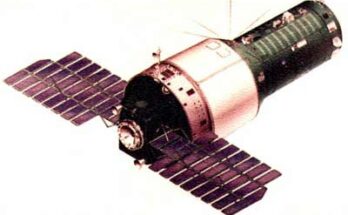By Bill Ostrove, Space Systems Analyst, Forecast International.

The U.S. Air Force has started an effort to build next-generation GPS (GPS III) spacecraft. The USAF’s Space and Missile Systems Center (SMC) issued a Request for Proposals (RFP) on January 8 to begin a Production Readiness Feasibility Assessment to study how prepared companies are for the manufacture of additional GPS III spacecraft that will follow the first 10 spacecraft that Lockheed Martin is building.
The GPS III program began in 2004 with the award of Phase A concept development contracts. The plan called for GPS III spacecraft to be purchased in three blocks, each with new features and capabilities. Lockheed Martin ultimately won a contract worth $1.46 billion in 2008 to build eight GPS III spacecraft. The U.S. Government Accountability Office estimates the total cost to design, build, and operate eight GPS III satellites to be $4.9 billion. With the first launch currently scheduled for August 2016, the GAO also found that Lockheed Martin was 28 months behind schedule. Lockheed Martin was eventually awarded an option to build an additional two GPS III Block A spacecraft.
The RFP issued on January 8 begins the search for a contractor to build 22 satellites. The Air Force decided to conduct a competition rather than award Lockheed Martin follow-on contracts; the service is unhappy with the launch delay and wants to use a competition to lower costs. Lockheed Martin will likely face competition from Boeing and Northrop Grumman.
According to a USAF statement, the solicitation is for a competitive, firm-fixed-price acquisition, with the potential of awards to three companies. Proposals are due by February 23, and the awards will be announced sometime in the spring. Following the contract awards, the performance period will last 26 months; two six-month options could be exercised. If all options are exercised, the program will last well into 2019. Inside GNSS reports that each contract will be worth $5 million, and each option – if exercised – will be worth $500,000. While these figures are relatively low, the initial contracts could lead to more lucrative contracts for the manufacture of the satellites.
The scope of the contracted work will provide insight into the contractors’ readiness efforts in preparation for a competition to produce the space vehicles (SVs). The contract winners will need to provide the USAF with access to their design capabilities and will need to perform a demonstration of navigation payload capability.
Compared with previous USAF navigation satellites, GPS III spacecraft will feature increased signal power to reduce jamming and improve location accuracy. The spacecraft will field L1C signals that will be interoperable with European Galileo and Japanese Quazi-Zenith satellites.
The GPS III SV 11 and subsequent variants will use GPS III SV 1-10 requirements as their design baseline. The Air Force also requires the addition of a redesigned nuclear detonation detection system government-furnished equipment hosted payload, a search-and-rescue/GPS GFE hosted payload, a laser retro-reflector array GFE hosted payload, a unified S-band compliance capability, and a regional military protection capability. No changes are allowed to the GPS next-generation operational control system or military GPS user equipment interfaces.
With the cost of each satellite approaching $200 million, the winning firm will be awarded a lucrative contract. With Boeing, Northrop Grumman, and Lockheed Martin as the three likely companies to bid on the solicitation, the Pentagon will decide which is the most ready to produce 22 satellites. At one point, Lockheed Martin appeared to be the favored company to build all GPS III spacecraft, but that is not the case anymore. All three companies have a roughly equal chance at this point.
For 50 years, Forecast International intelligence reports have been the aerospace and defense industry standard for accurate research, analysis, and projections. Our experienced analysts compile, evaluate, and present accurate data for decision makers. FI's market research reports offer concise analysis of individual programs and identify market opportunities. Each report includes a program overview, detailed statistics, recent developments and a competitive analysis, culminating in production forecasts spanning 10 or 15 years. Let our market intelligence reports be a key part of reducing uncertainties and mastering your specific market and its growth potential. Find out more at www.forecastinternational.com




